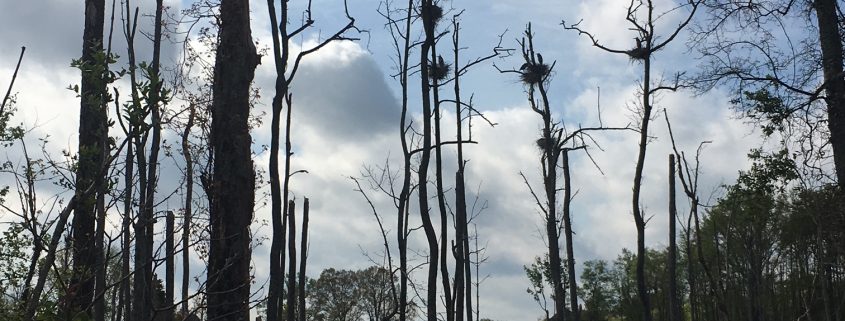Where Is Wild and How Do We Recognize It?
And for as long as I stay here, I know I will also have to get to the wild places. And this was the vision of a world place that had stayed with me: somewhere boreal, wintry, vast, isolated, elemental, demanding of the traveler in its asperities. To reach a wild place was, for me, to step outside human history… where the evidence of human presence was minimal or absent.
The Wild Places (Robert Macfarlane)
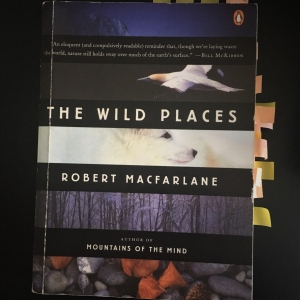
The Wild Places traces the author’s discovery that wildness is as much a state of mind and perception as it is boreal, wintry, vast, isolated, elemental, demanding of the traveler in its asperities. I’ll insert Macfarlane’s observations within this Post as I offer my own reflections on wildness.
We lived four years in Fairbanks, Alaska, an modestly urban area four hundred miles north of Anchorage and just one hundred miles south of the Arctic Circle, centered within the vastness of interior Alaska. We lived in the Chancellor’s Residence on the University of Alaska Fairbanks campus. We welcomed and enjoyed our backyard moose visitors. Not quite MacFarlane’s boreal, wintry, vast, isolated, elemental, demanding of the traveler in its asperities, yet much more so than our current home in northern Alabama.
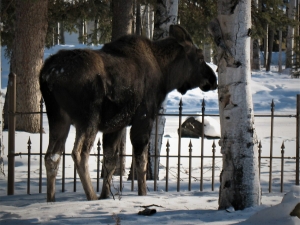
The same with Sitka, Alaska, another locale and clime in line with MacFarlane’s wildness. In fact, just like Fairbanks, leave the city limits and you are engulfed in vast true wilderness.
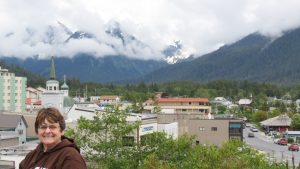
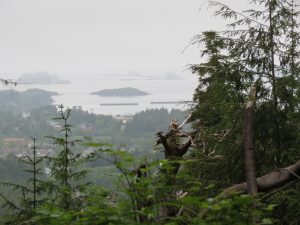
Nature’s Wildness: Lessons from an Epic Movie
As a forester, I recall the wonderful cinematography of the 1992 Last of the Mohicans movie, the classic French and Indian war epic situated in New York’s Adirondack Mountains. In the interest of historical accuracy, I knew that crews filmed the movie in North Carolina’s Appalachians. Still, I loved the forest and mountain scenes. The movie opened with a great chase sequence as one of the lead characters ran… hotly pursued through the forest primeval. Turns out that the forest primeval was a white pine forest planted by the Civilian Conservation Corps (CCC) on abandoned pasture land near what is now the Biltmore Estate, Asheville, NC. So, planted early the 1930s, the forest filmed about 1990 had developed over 55-60 years, an artificial forest.
Forest primeval? Not hardly. Yet perception is reality. I’ve seen hundreds of old CCC plantations. The evergreens (whether white, red, or Scots pine, or Norway spruce) quickly captured the site, excluding competing vegetation, and often standing thickly above an unusually vacant forest floor. I suppose the towering trees above a needle-carpeted, open forest floor met the film-maker’s need. It worked quite well. Our hero raced across the landscape to the delight of movie-goers. Having inside forestry knowledge, I admit, enhanced my own viewing pleasure. What a great subterfuge! Managed forests are forests all the same. What appears wild in the eyes of millions was all the wildness required.
Virtually the entire Appalachians, from Georgia to Maine saw widespread removal of the original forests through the nineteenth century, attempted domestication to subsistence farming, and eventual abandonment, with forests once more clothing the hillsides. Whether planted by the CCC or naturally regenerated, the forests once more appear ancient and untrammeled by the hand of man. The same holds true across Alabama. Maturing second (and third) growth forests dominate land use. Wild is infiltrating where we live
I served four years of my 12-year Union Camp Corporation employment conducting forest fertilization research. I recall many of the replicated trials we established to test hardwood plantation fertilization at stand establishment in Virginia and North Carolina. We installed 0ne of the first locations on Jordan Pocosin (our name for the tract) in Gates County, NC, on the coastal plain south of the Meherrin River. We selected the site prior to forest harvest. Post-harvest we mechanically site-prepared by wind-rowing tops and residual stems, harrowing the area between windrows, and then bedding linearly parallel to the windrows. The raised beds improve micro-drainage on these somewhat poorly drained, clayey gleyed soils. We winter-planted sweetgum seedlings early 1976 and applied fertilizer treatments that spring. I recall measuring the plots at the end of growing seasons ‘76, ‘77, and ‘78 prior to my transfer to the Corporate Office of Environmental Affairs in Savannah, Georgia. By then, we documented clear treatment growth differences, and some individuals reached heights of 10-12 feet.
I next stepped foot on the plots during the 2003-4 dormant season, a quarter-century later. I met on-site with some of my old Union Camp colleagues, including the person who had been my principal technician. International Paper Co. had purchased UCC ten years prior to our return visit, the research project long since abandoned. The east-west access road, I recalled, had entered the cleared and site-prepared tract. It now passed through a seeming mature forest in deep shade. We stopped where Lloyd felt we had placed the ten-acre installment. We soon located some of the treated corner posts designating measurement plots. Sweetgum in straight rows on still-identifiable beds stood 70-90-feet-tall, some approaching 15 inches in diameter. A few oak and loblolly had invaded, especially along the windrows. Like the Biltmore white pine plantation, this artificial forest projected an essence of the forest primeval. Had someone placed me on-site without explanation I feel certain my forensic professional examination would have discovered telltale signs: these odd treated posts; linear beds; sweetgum on the bed-tops; the windrow strips with other than sweetgum dominant. For the uninitiated non-forester, this was a mature stand of coastal plain forest… forever wild and natural. Again, not hardly. Yet what we see is reality.
Wild is temporal… we established this field-test on what most would agree was a domesticated tract (albeit remote from the nearest town), far from wild. Twenty-five years had returned the site to wild, and seemingly untrammeled. Although my reunion visit with old friends on a site where I had spent scores of hours lifted me and brought back rewarding memories, I once more experienced a sobering (and mind-boggling) time-journey. My friends and I, then a generation older, distantly resembled our younger selves physically, yet our discourse did not show the weathering and aging. We laughed heartily of times undimmed. The land, too, had not changed, even as its forest development rendered the site unrecognizable! Does the land and its vegetated cover possess spirit and soul undimmed by time, even as its facial features and body age?
Just as wildness is a term we pass through our subjective filters, I know that I ascribe elements of soul and spirit to places I’ve encountered over my journey. Jordan Pocosin, although it does not stand as one of THE prime examples, does hold a special significance in my life. As I reflect on our 2003-04 reunion visit, I recognize that we all felt a sense of soul and spirit that day, partly defined by our shared memories and otherwise leveraged by our acceptance of the power and persistence of nature to keep this wildland wild. Mount Washington, New Hampshire is one of THE standard bearers in my soul/spirit place-memory portfolio. From my first book, Nature Based Leadership:
This mountain spurs deep spirituality in me. I feel closer to something far greater than myself, whether religious or secular. I departed Mount Washington once more accepting absolute humility and feeling full inspiration. A healthy balance: a reminder that each of us is simply a cog in a far greater system (or a business, a family). We are mere moments across the vast sweep of time. The mountain will stand high for millennia, long after I have passed. MWO’s (Mount Washington Observatory) Brian Fowler emailed me the Sunday after our ascent, sharing similar sentiments: “Well, you now know one of the principal reasons I stay connected with the observatory. Once it gets into your blood (for me now almost fifty years ago), it’s there permanently and always available as a wonderful palliative to this otherwise perplexing world.
I often found projectile points as we remeasured the Jordan Pocosin trial, evidencing that Native populations frequented the area long before the first European influences 250 or so years ago. Certainly not “boreal, wintry, vast, isolated, elemental, demanding of the traveler in its asperities,” wildness still characterizes for most citizens this large tract of land within 90 minutes of Tidewater (Norfolk, Hampton Roads, Virginia Beach) Virginia and Raleigh, North Carolina. To all but the trained naturalist observer, “the evidence of human presence was minimal or absent” in Jordan Pocosin!
Macfarlane likewise began rejecting the defining essence of wildness he had embraced and believed as he began contemplating The Wild Places:
Lying there on the drifted sand, under the white stars, I thought about how the vision of wildness with which I had begun my journeys – inhuman, northern, remote – was starting to crumble from contact with the ground itself. No such chaste land exists in Britain or Ireland, and no such myth of purity can hold. Thousands of years of human living and dying have destroyed the possibility of the pristine wild… The human and the wild cannot be partitioned.
The Wild Places (Robert Macfarlane)
Wilderness and Wildness
The US Wilderness Act of 1964 defined the term: “A wilderness, in contrast with those areas where man and his own works dominate the landscape, is hereby recognized as an area where the earth and its community of life are untrammeled by man, where man himself is a visitor who does not remain.” I do not contest this legislative characterization of formally protected areas within the US Wilderness system. Such designation offers protection long term and controls access and use. I distinguish a formal Wilderness from wildness. The US National Forest System comprises 193 million acres (~301,000 square miles) and includes 36 million acres of the Nation’s 109 million Wilderness acres. Within Alabama’s 667,000 acres of National Forests, we have ~42,000 acres of federally-designated Wilderness (Dugger Mountain, Cheaha, and Sipsey). Six percent of Alabama’s National Forest acreage is designated Wilderness. However, most outdoor enthusiasts would agree that virtually the entire 667,000 acres qualify as what I term wildness, which does not require a condition untrammeled by man, where man himself is a visitor who does not remain.
True federal Wilderness meets a legislative intent far deeper and more specific than wildness:
If future generations are to remember us with gratitude rather than contempt, we must leave them a glimpse of the world as it was in the beginning, not just after we got through with it.
Proclaimed by President Lyndon B. Johnson upon signing the Wilderness Act of 1964
In order to assure that an increasing population, accompanied by expanding settlement and growing mechanization, does not occupy and modify all areas within the United States and its possessions, leaving no lands designated for preservation and protection in their natural condition, it is hereby declared to be the policy of the Congress to secure for the American people of present and future generations the benefits of an enduring resource of wilderness.
Excerpt from the Wilderness Act of 1964
Aldo Leopold would have supported the Wilderness Act. He died the year preceding A Sand County Almanac’s posthumous publishing date. He yearned to ensure that future citizens have access to what he called blank spots on a map:
I am glad I shall never be young without wild country to be young in. Of what avail are forty freedoms without a blank spot on the map?
Aldo Leopold, A Sand County Almanac (1949)
My own sense of wildness has shifted over the five decades since I began seriously contemplating nature and wildness. We built our retirement home (December 2015) on a four-acre pond/lake in northern Alabama’s Tennessee River Valley near Huntsville. Ours is the largest of a string of three bodies of water. We chose the lot because of the water and the feeling of openness it would give us even in a residential development. In retrospect, after three years in residence, we found that we had underestimated the incredible peace of mind and sense of wildness it has actually provided. In my younger years, this now aging forester would have seen only the homes ringing the shoreline, and with some measure of contempt for the urban invasion. Now I see only the pond, the open views, and the rich wildlife attracted.
My idea of wildness as something inhuman, outside history, had come to seem nonsensical, even irresponsible.
The Wild Places (Robert Macfarlane)
As I had moved south, my own understanding of wildness had been altered – or its range had been enlarged. My early vision of a wild place of somewhere remote, historyless, unmarked, now seemed improperly partial. But I had learned to see another type of wildness, to which I had once been blind: the wildness of natural life, the sheer force of ongoing organic existence, vigorous and chaotic. This wildness was not about asperity, but about luxuriance, vitality, fun. The weed thrusting through a crack in the pavement, the tree root impudently cracking a carapace of tarmac: these were wild signs, as much as the storm wave and the snowflake.
The Wild Places (Robert Macfarlane)
The weed thrusting through a crack in the pavement within a hundred yards of our Alabama home, a wild sign along with the momentarily stunned male house finch (hit a window) on our patio:
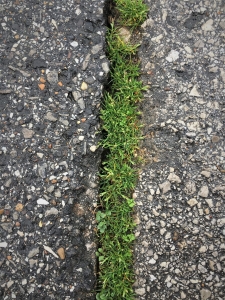
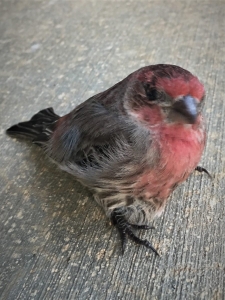
Within a few miles of our home, a heron rookery stands in a wetland surrounded by subdivisions. Wildness is where we seek it.
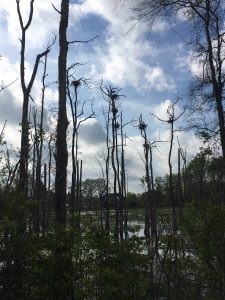
Again, wildness is where we seek it.
Reflections on Nature, Humanity, and Wildness
Human history and natural history are inseparable. We humans are not interlopers on this third rock from the sun. We are not invaders. We are residents… native to Earth. We are here because this is home — because this is the place that spawned us. There is not humanity and nature. There is simply nature… and we humans are integral to it. I intentionally avoided probing the depths of humanity in nature. Instead, I chose to state within this chapter that humanity is integral to nature. And that wildness is a malleable construct. Take for example an April, 2018 hike I took at nearby Monte Sano State Park, which offers 22 miles of trails. All of these trails wend well within the humanity/wildness interface zone. European settlement and influence have marked this not-so-back-country for two centuries.
The State Park and adjoining Northern Alabama Land Trust trail system are testament to those who recognized our interdependence with nature and took measures to protect and preserve wildness within reach of the Huntsville, Alabama community. In his 1948 Foreword to A Sand County Almanac, Aldo Leopold observed, “There are those who can live without wild things, and some who cannot. These essays are the delights and dilemmas of one who cannot.” I offer my compliments and appreciation to those who cared (and care) enough to conserve and tend wildness on Monte Sano. Again, we are one with nature and what better way to remind us than hiking a wild area rich with human history.
We know that Native Americans lived in this region for twelve millennia. They left a far lighter touch on wildness than European settlement has over two short centuries of occupation. No historic markers designate their former dwellings at Monte Sano. Nearly two hundred years ago, Col. Robert Fearn built a one-and-one-half-story summer home atop Monte Sano at 1,600 feet. Fire destroyed the structure 55 years later. A subsequent landowner, James O’Shaughnessy, built a two-story Victorian residence nearby in 1890. Among other endeavors, he co-owned the Monte Sano Hotel, also nearby atop the plateau.
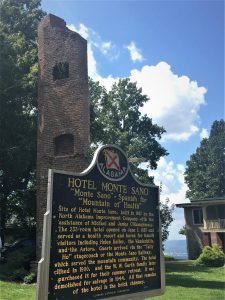
Two homes and associated out-buildings and a full-service hotel. Permanent man-made features on the plateau landscape, right? Not hardly — nature’s eraser assures that little is permanent. The entire area we hiked is closed forest, appearing to the uninitiated as forest primeval. Sure, we saw a couple stone gate posts, a remnant brick-lined in-ground cistern, and abandoned roads, long-since re-naturalized as part of the forest floor. The maturing forest signaled subtle successional changes to me, evidencing that some acreage had been cleared. A heritage sign stands at what had been a fish pond and then a lily lake at the hotel. The forest, as it has with the abandoned road beds, is reclaiming the pond. Organic debris is transforming the open water to deep, soggy muck. Trees and shrubs are finding purchase. Next step — a vernal pool, then a wet depression. That interpretive sign and others memorialize the valiant efforts to domesticate a northern Alabama mountain-top.
Leonardo da Vinci noted quite simply and elegantly: “Nature never breaks her own laws.” One of nature’s preeminent truths is that nothing is permanent, whether a spring ephemeral wildflower, our own lives, or a hotel and spa atop a plateau overlooking the Tennessee River Valley. Nothing can withstand the force and power of nature’s agents (biotic, chemical, and physical) acting over time. I remind you that the Appalachians once stood at elevations rivaling today’s Himalayan Mountains.
Wildness on the Seventeenth Floor at Atlanta’s Hartsfield
Wildness has often intersected my life’s journey… sometimes when I least expected it to appear. I offer this excerpt from Nature Based Leadership, my first book. January 2016, I had traveled to Atlanta from New Hampshire and awaited a scheduled conference room airport interview as I relaxed and prepared in the hotel’s executive lounge near Hartsfield. I had made the initial cut to semi-finalist for another university presidency.
The executive lounge looked south from the seventeenth floor. FedEx’s Atlanta operations spread out beneath us, the commercial airport beyond that. I could hear and feel the wind swirling around the building, even on this sheltered lee side. Making myself at home, I pulled out my laptop, secured connectivity, and went about conducting the business of the university that employed me, occasionally revisiting my notes and background materials for the interview. Peripherally, I noticed a fellow lounge occupant near the window, camera in hand. I rose to see the object of her attention. There on the eight-inch-wide window ledge more than one hundred fifty feet above the ground stood a peregrine falcon.
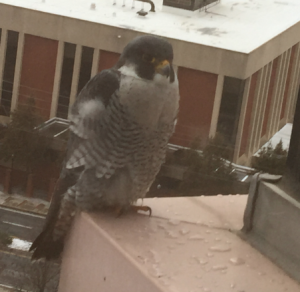
The morning gale had obviously buffeted my window ledge falcon. Although now somewhat protected, feathers still in disarray, the bird evidenced its wind-bludgeoning. My dominant initial impression of the bird, within arm’s length beyond the glass, filtered through my own lens as an unabashed champion of accipiter species and other birds of prey, amounted to wonder, awe, beauty, and inspiration. I did not contemplate its ruffled feathers at first, only marveled that this incredible bird had suddenly appeared on such a blustery morning on my seventeenth-floor ledge! Only later when viewing peregrine photos online did I truly appreciate how bedraggled this one looked.
Eventually as I watched, the bird looked away and — with wings open — slipped gracefully from the ledge. It dipped below my line of sight and did not reappear. I sensed great blessing and pleasure having simply been there to see the peregrine up close and personal. I knew the species had adapted to urban high-rise life and had acquired a taste for European pigeon cuisine — fresh off the wing. Perhaps a pigeon below had prompted the bird to leave me behind.
Most importantly, I found solace that this daring bird of prey, this thing of wild beauty, this symbol of nature’s fury and mastery, had alighted on a seventeenth story ledge during that brief period when I was wrestling with a personal and professional dilemma, and at a time when a mid-Atlantic coastal storm had ushered some rough weather into the Southland. The mix allowed me to look deeply into urban wildness and its temporal intersection with my life and my inner self. I see more clearly through the filter and magnification of nature’s lenses. I am grateful for every opportunity I have to look, see, feel, and act. A lesson in nature, or one inspired by nature? I accept either, with deep appreciation for yet another chance to experience, learn, and grow.
There was wildness at a high-rise hotel within sight of the world’s busiest airport! As Robert Macfarlane so eloquently discovered and related in The Wild Places, wildness is subject to our own filters. I accept and embrace his simple statement that what we can fundamentally celebrate is “the wildness of natural life, the sheer force of ongoing organic existence, vigorous and chaotic.”
I urge readers to awaken to the wildness that is within reach of where you live. Take time to visit. Believe (and know) that you will likely discover far more than you seek, as John Muir so eloquently observed: In every walk with nature one receives far more than he seeks. Hike and Look. Look and See. See and Feel. And Feel and Act — to make some small corner of the world better through wisdom, knowledge, and hard work. And realize that nature’s laws apply to living, learning, serving, and leading. To vocation and avocation. To enterprises of all sorts… from family to church to community to business.
Macfarlane’s dear deceased hiking companion had said, “There is wildness everywhere, if only we stop in our tracks and look around us.” From The Wild Places, “To him, the present-day and the close-at-hand were as astonishing as the long-gone and the far-afield. He was an explorer of the undiscovered country of the nearby.”
Like Aldo Leopold, I am one who cannot live without wild things. May nature’s wildness inspire all that you do! Be an explorer of the undiscovered country of the nearby. Reveal and cherish the present-day and the close-at-hand!
Life Lessons and Wisdom from Wildness — Wherever We Choose to Savor It
I won’t attempt to offer esoteric lessons from nature (with full explanation, interpretation, and reference citations) to close this chapter. Instead, here are a few rather simple conclusions:
- Wilderness is a subset of wildness
- Wildness is as much state of mind as an objective, criteria-defined condition
- Wildness is spatial and it is temporal
- Life (or wildness) is what we make of it — I am seeking and finding nature and some level of wildness in a classic suburban development, even in very urban settings
- I am securing my daily bread of nature and wildness right in my backyard
- Nature is adaptable to human habitation — after all, we are one with nature
- I sincerely wish more people could appreciate, understand, and enjoy nature’s beauty, awe, magic, and wonder – that more people would explore the undiscovered country of the nearby and reveal and cherish the present-day and the close-at-hand
- Life can be as good as we care to make it
Nature and its associated wildness soothes my soul, stirs my passion, stimulates my life-purpose, and lifts my spirits. Nature and wildness are two fundamental ingredients in my daily bread.
Thoughts and Reflections
I wrote my books (Nature Based Leadership (2016) and Nature-Inspired Learning and Leading (2017)) and the two scheduled for 2019 (Weaned Seals and Snowy Summits: Stories of Passion for Place and Everyday Nature and Natural Elixir: Lifting Your Life through Nature’s Inspiration) to encourage all citizens to recognize and appreciate that every lesson for living, learning, serving, and leading is either written indelibly in or is powerfully inspired by Nature. Both published books are available on Amazon and other online sources.
Here are three succinct lessons I draw from this Blog Post:
- In every walk with nature one receives far more than he seeks (John Muir).
- Nature is adaptable to human habitation — after all, we are one with nature.
- Explore the undiscovered country of the nearby and reveal and cherish the present-day and the close-at-hand.
Inhale and absorb Nature’s elixir. May Nature Inspire and Reward you!
Note: All blog post images created & photographed by Stephen B. Jones unless otherwise noted. Please circulate images with photo credit: “©2019 Steve Jones, Great Blue Heron LLC. All Rights Reserved.”
Another Note: If you came to this post via a Facebook posting or by an another route, please sign up now (no cost… no obligation) to receive my Blog Post email alerts: https://stevejonesgbh.com/contact/
And a Third: I am available for Nature-Inspired Speaking, Writing, and Consulting — contact me at steve.jones.0524@gmail.com
Reminder of my Personal and Professional Purpose, Passion, and Cause
If only more of us viewed our precious environment through my own filters. If only my mission and vision could be multiplied untold orders of magnitude:
Mission: Employ writing and speaking to educate, inspire, and enable readers and listeners to understand, appreciate, and enjoy Nature… and accept and practice Earth Stewardship.
Vision:
- People of all ages will pay greater attention to and engage more regularly with Nature… and will accept and practice informed and responsible Earth Stewardship.
- They will see their relationship to our natural world with new eyes… and will understand more clearly their Earth home.
Tagline/Motto: Steve (Great Blue Heron) encourages and seeks a better tomorrow through Nature-Inspired Living!


